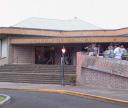This article was first published in Vyuz San Diego.-DM
San Diego–San Diego is home to many fine museums including one that doesn”™t actually exist: The Museum Of Hoaxes.
Well, it doesn”™t exist except online but the man behind it, Alex Boese (Burzha), says some people think it does.
Boese operates the MuseumOfHoaxes.com website to help disprove various hoaxes on the internet and in real life.
One of the pages on the site features a picture of a building that is supposedly the real home of the museum. Except it”™s not.
The museum only exists online but that doesn”™t stop some readers from e-mailing him for directions or Boese from dreaming about building a brick-and-mortar version somewhere in San Diego where people could learn about various forms of fakery.
Until that happens, amateur hoax historians will have to settle for the online museum and Boese”™s new book, “Hippo Eats Dwarf: A Field Guide To Hoaxes And Other B.S.” (Harcourt), which hits stores on, appropriately enough, April Fool”™s Day, a national holiday for pranksters.
It might be fun to fool your friends on April 1, but Boese, a La Mesa resident who holds a master”™s degree in history from UCSD, doesn”™t recommend people actually commit media pranks on April Fools Day.
“It”™s a bad day,” he says. “Any strange story gets extra attention on that day.”
The title for Boese”™s book comes from a ten-year-old “news story” about a circus dwarf named “Od,” who supposedly was eaten by a hippo when he bounced badly off a trampoline right when the creature was yawning.
It”™s a great story. That”™s why it was reported in the Manchester Evening News, the Sydney Daily Telegraph and the Pattaya Mail in Thailand.
But it”™s completely fake. Despite that, a Google search for the story yields 15,000 hits, including one for a band who used the headline as its name.
Boese created the Museum Of Hoaxes to raise awareness about how stories get faked and how to tell a real weird story from a manufactured weird story. He says the internet has made it easier to hoax stories but also easier to disprove the facts.
For instance, many web sites seem to promote new ideas or opinions and Boese says the chances of a hoax increase dramatically if the people behind the website are trying to sell t-shirts.
There are many different types of hoaxes but Boese says some are good and others are bad.
“Good hoaxes have a social purpose and show how easy it is to fool people.”
One example of a good hoax might be the campaign by famed prankster Joey Skaggs, where he pretended to be a Gypsy offended with the name of the Gypsy Moth or the MIT scientists who created “Bonsai Kittens,” a way of raising a cat inside a jar so its shape corresponds with the container.
On the other hand, Boese says bad hoaxes include bomb scares, Nigerian rip offs and fake abductions, like the one perpetuated by last summer”™s “runaway bride” Jennifer Wilbanks.
No one knows what the hoaxes of the future will be, but Boese is pretty sure there will always be some people who want to fool at least some of the people some of the time. However, he hopes his guide raises the bar for fakery.
“I appreciate the humor of a good hoax but it”™s up to people to recognize them. One of the things about the internet is that weird stories get out quicker but they get debunked just as fast.”
For more information on Boese, log onto museumofhoaxes.com.
© 2006 David Moye
David Moye is the Arts and Features editor for Vyuz.

